This article will focus on the technical principles, current situation, and development roadmap of zkLink, providing a comprehensive analysis of the multi-chain aggregation layer based on ZK-Rollup technology - zkLink.
Author: Biteye core contributor Viee
Editor: Biteye core contributor Crush
* The full text is about 4500 words, with an estimated reading time of 8 minutes
From Layer 1, Layer 2 to Layer 3, the blockchain island effect is becoming more prominent, and multi-chain interconnection is receiving more attention. One gives birth to two, two gives birth to three, and three gives birth to all things. Whether there will be L4, L5, Ln above L3 is currently unknown. One of the most pressing issues at present is how to integrate dispersed liquidity islands. zkLink addresses this issue by proposing a solution for aggregating multi-chain liquidity.
This article will focus on the technical principles, current situation, and development roadmap of zkLink, providing a comprehensive analysis of the multi-chain aggregation layer based on ZK-Rollup technology - zkLink.
01 What is zkLink and what problem is it trying to solve?
With the development of blockchain technology, from the emergence of Layer 1 (L1) such as Ethereum, Solana, to the rise of Layer 2 (L2) such as Arbitrum, Optimism, zkSync, and Starknet.
While meeting the needs of different users, it has also brought about problems such as fragmented liquidity and high cross-chain costs. In addition, developers face increased complexity when deploying dApps due to different chain programming languages and tools.
Imagine a country made up of islands, with inconvenient transportation and an immature financial system, where each island (blockchain) has its own independent currency and trading system.
You want to shop between different islands (such as Ethereum, Solana, Arbitrum), but each time you cross an island, you need to exchange currency, pay fees, and worry about losing money.
This is the current interaction dilemma faced by blockchain users: fragmented liquidity, high transaction costs, and insecurity.
How can cross-chain transactions become as convenient and secure as transactions on the same chain? zkLink provides the answer.
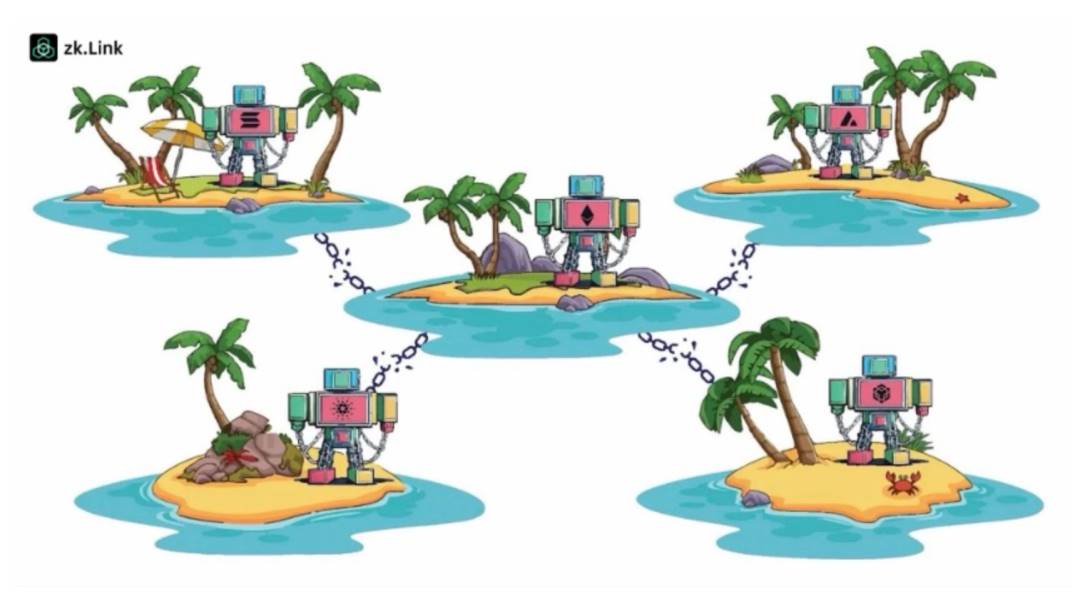
(Source: zkLink official website)
By using zero-knowledge proofs (ZKP) technology to unify L2 and L1, zkLink achieves multi-chain state synchronization and native asset aggregation.
Tokens issued on different L1 chains and L2, such as USDT Ethereum, USDT BSC, will be merged into a single USDT token in zkLink Rollups.
In other words, this island country now has a comprehensive trading center that aggregates the currencies of different islands on one platform, eliminating the need for frequent currency exchanges, high fees, or concerns about asset security. This is the multi-chain liquidity aggregation function achieved by zkLink, far surpassing "cross-chain bridges".
Based on this, zkLink has developed two main products: zkLink Nova and zkLink X
zkLink Nova is the first aggregated L3 zkEVM Rollup network built on Ethereum and Ethereum L2, which aggregates assets from multiple L2 networks on Ethereum using zero-knowledge Ethereum Virtual Machine (zkEVM) to solve Ethereum's liquidity and asset fragmentation issues.
zkLink X is an aggregated Rollup infrastructure that supports customized multi-chain dApp development, connecting L2 and L1, allowing developers to feel like they are building applications on a single chain, while in reality, they can access liquidity from multiple chains.
Returning to the analogy of blockchain and islands, zkLink Nova is like a universal shopping card, allowing you to freely shop (interact) between various different island malls without the need to repeatedly exchange currency.
And zkLink X is like a universal toolbox, allowing you to customize the type of mall store (dapp) you want to build according to your needs, like building with building blocks, and these stores also support currencies from different islands.
In this way, zkLink not only integrates liquidity dispersed across different chains, reduces transaction costs and security risks, but also simplifies the multi-chain deployment of dApps, improves user experience, and ensures the security of dApp development.
02 What solutions does zkLink provide and how does it stand out from the "multi-chain war"?
Multi-chain and cross-chain have been talked about for a long time, but we need to understand that zkLink is not a cross-chain bridge, but a chain that aggregates multi-chain liquidity.
So, how does zkLink achieve multi-chain aggregation?
The zkLink protocol is a multi-chain ZK-Rollup infrastructure composed of four levels, including the Settlement Layer, Execution Layer, Sequencer Layer, and Data Availability Layer, which are independent of each other and support customized application Rollup deployment. The core value of the zkLink protocol mainly lies in the Settlement Layer and Execution Layer.
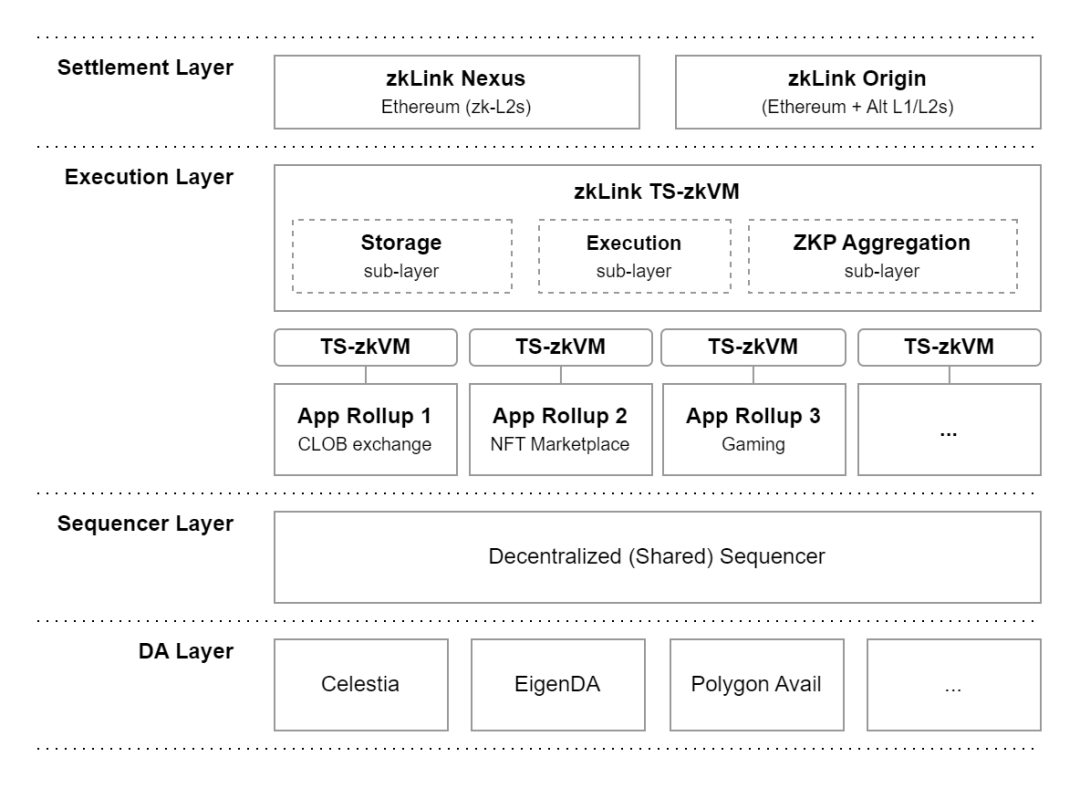
(zkLink protocol architecture Source: zkLink official website)
The Settlement Layer of zkLink, as the most core part, acts as an aggregated settlement center, integrating multiple chains and ensuring that each transaction can be verified on multiple chains through synchronization technology to prevent fraudulent operations.
There are currently two settlement solutions: zkLink Nexus and zkLink Origin, each targeting different network integration needs.
zkLink Nexus: Connects Ethereum and its L2 network, inheriting the security of Ethereum.
zkLink Origin: Can connect other L1 public chains (such as Solana) and Ethereum to provide broader integration.
Traditional Cross-Chain vs. Multi-Chain Aggregation
Trading between different blockchains leads to increased costs and complexity. Whether it is "traditional cross-chain" or "multi-chain aggregation," both are solutions to this problem. Let's take an example, think about exchanging tokenA on chainA for tokenB on chainB through a DEX, what is the most primitive way?
First, you need to install a wallet and purchase gas tokens for chainB;
Next, the user needs to trade tokenA for stablecoins or other intermediate tokens that can be bridged to chainB;
Finally, the user needs to purchase tokenB on the local DEX.
Compared to cross-chain transactions, this process is clearly more complex and costly, so the emergence of cross-chain bridges has improved this experience to some extent.
However, the cost of cross-chain token transactions is still high, and users still find it difficult to seamlessly and inexpensively interact with tokens across different chains.
In addition, traditional cross-chain solutions often have a high degree of centralization, making them vulnerable to hacking, which increases the risk of user funds being stolen.
Unlike traditional cross-chain solutions, zkLink provides a more secure multi-chain settlement solution, namely the Nexus and Origin mentioned earlier, both of which utilize zero-knowledge proof technology (ZKPs).
zkLink creatively applies zero-knowledge proofs to multi-chain interoperability, using a decentralized and distributed design that does not require third parties to ensure the security of assets and transactions, while ensuring the security and consistency of transactions and state transitions, reducing the risk of asset custody, greatly enhancing security and efficiency.
From Layer 2 to Aggregated Layer 3
In addition to multi-chain aggregation, zkLink's highlight is that it has built the third layer zkLink Nova to integrate the liquidity islands of the Ethereum L2 ecosystem.
Why build L3 to unify the liquidity of the L2 ecosystem?
We all know that the rise of L2 has added a "highway" to Ethereum, making transactions faster and cheaper, but at the same time, it has created a non-interoperable and fragmented blockchain landscape, where liquidity is trapped in isolated chains.
Native assets on different L2s of Ethereum (such as ARB, OP, MANTA, etc.) cannot be interoperably traded, and transfers are often time-consuming and costly. The dispersion of different assets on various L2 networks has led to the waste of liquidity.
The increasing number of L2s, sidechains, and decentralized applications has caused liquidity fragmentation, which runs counter to the goal of achieving usability for Ethereum.
This is the cost of Ethereum developing L2. It has dispersed liquidity to dozens of blockchains and urgently needs a more advanced solution to improve interoperability and efficiency.
Compared to most L3s that are designed to meet specific application requirements and deployed on a single L2 (such as Starknet or Arbitrum), zkLink Nova is a universal L3 aggregation network built on Ethereum and multiple L2 networks, with Ethereum and its L2 serving as the settlement layer.
So, zkLink's construction of L3 zkLink Nova is not just about making each layer cheaper than the previous one, but also with the vision of "one Nova ruling the world."
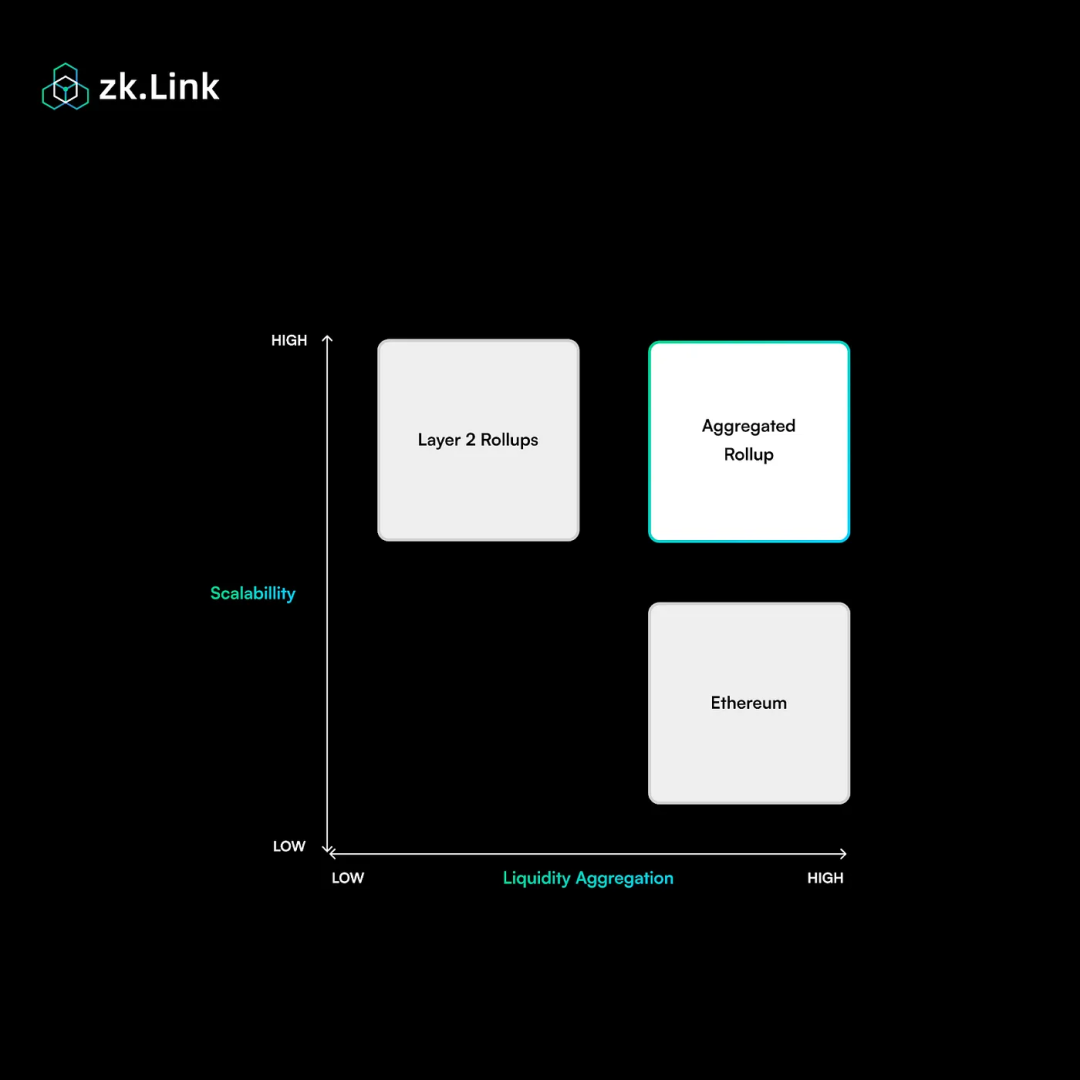
(Source: zkLink official website)
In simple terms, ETH deposited on different L2s will automatically merge into the same ETH on Nova.
The same ERC-20 tokens bridged from different networks, such as USDC.Ethereum, USDC.Arbitrum, can be merged into the same USDC on Nova, and the merged USDC on Nova has unified liquidity, thereby enhancing scalability and optimizing user experience.
zkLink vs. Other Aggregation Solutions
Many L2s have also recognized the problem of liquidity fragmentation and have attempted to address it. For example, OP's Superchain, Polygon's AggLayer, zkSync's Hyperbridge, aim to unify liquidity by providing a unified bridge or shared sequencer.
However, they are only applicable to their independent sub-ecosystems and specific technical stacks. In this case, having multiple different technical stacks may exacerbate liquidity fragmentation and cross-chain interoperability issues, leading to further fragmentation of the Ethereum ecosystem.
In contrast, any asset on the second layer connected by zkLink Nova can be bridged to the third layer network to achieve fast and interoperable transactions. Although it sacrifices the atomic interoperability of cross-aggregated transactions, it provides the most extensive liquidity aggregation for the entire Ethereum ecosystem.
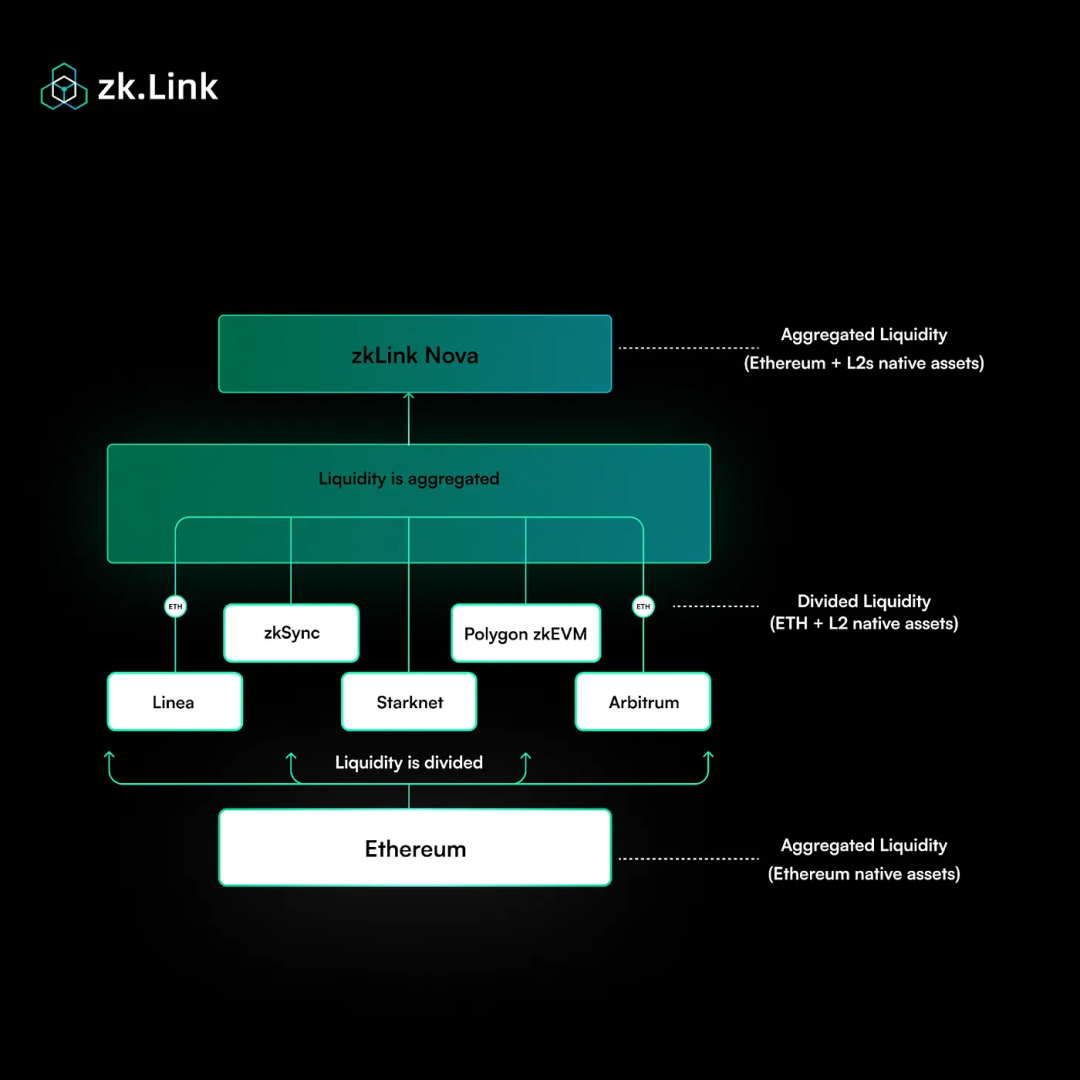
(zkLink Nova protocol architecture Source: zkLink official website)
03 From Now to the Future, zkLink and the New Cross-Chain Era
Current Development
Since the mainnet launch in March 2024, the zkLink Nova ecosystem has made significant progress, covering over 90 partner projects as of early May (the data in the image was officially released at the end of March and has not been synchronized), involving DeFi, tools, social, gaming, NFT, etc.
On March 14, zkLink Nova launched the first season of the "Aggregation Parade" reward event, which lasted for a month. It included opportunities to earn Nova points for assets such as ETH, L2 native tokens, stablecoins, LST, and LRT, encouraging users to deposit assets into the L3 Nova mainnet.
In simple terms, users can earn Nova points through cross-chain transactions, staking, and inviting new users, which can be exchanged for ZKL tokens in the future.
Currently, the second season of the "Aggregation Parade" reward event is ongoing, and Nova points can be earned by interacting with dApps collaborating with zkLink Nova.
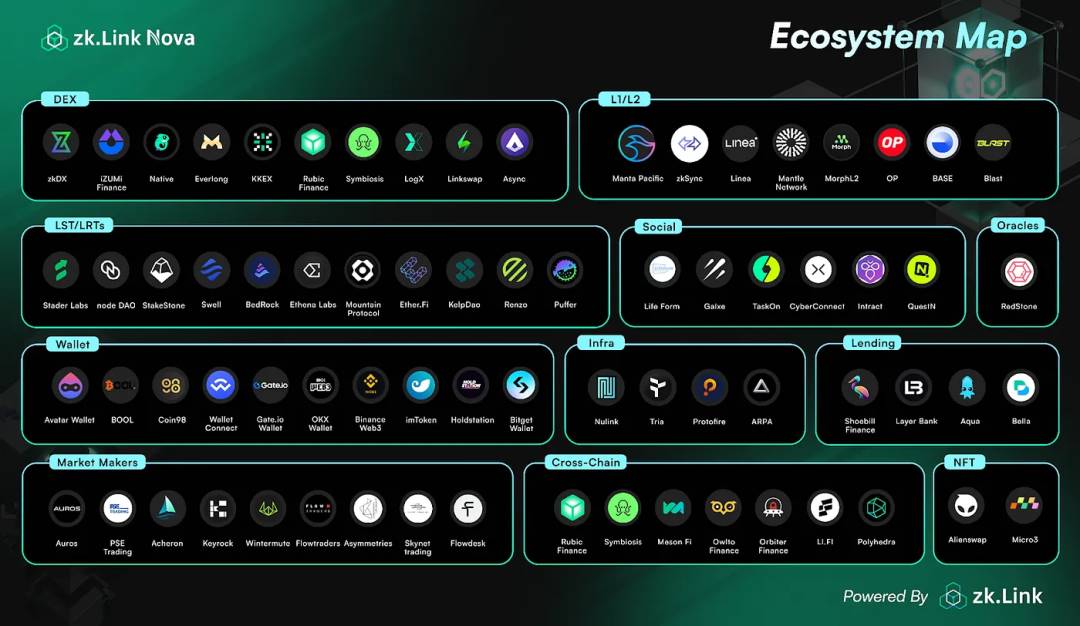
(zkLink ecosystem Source: zkLink official website)
From the above activities, it can be seen that the team has put a lot of effort into promoting user growth in the zkLink Nova ecosystem, and the data performance is also impressive.
The running Alpha mainnet has processed over 2 million transactions using zkLink technology and generated 500,000 unique addresses.
According to DefiLlama, as of May 22, zkLink Nova TVL has exceeded $1 billion, with a 156% increase in the past month, making it the highest TVL Layer 3 network.

(zkLink Nova total value locked Source: zkLink Nova official website)
Funding
In terms of funding, zkLink raised $4.68 million through a community sale on CoinList in January this year. In May last year, zkLink completed a $10 million strategic financing round, with participation from Coinbase Ventures, SIG, BigBrain Holdings, and others.
So far, zkLink has raised a total of $23.18 million, which will further develop the Nova protocol.
The investors in zkLink are more strategic partners, providing not only funds and manpower but also more resources to deepen their cooperation with zkLink.
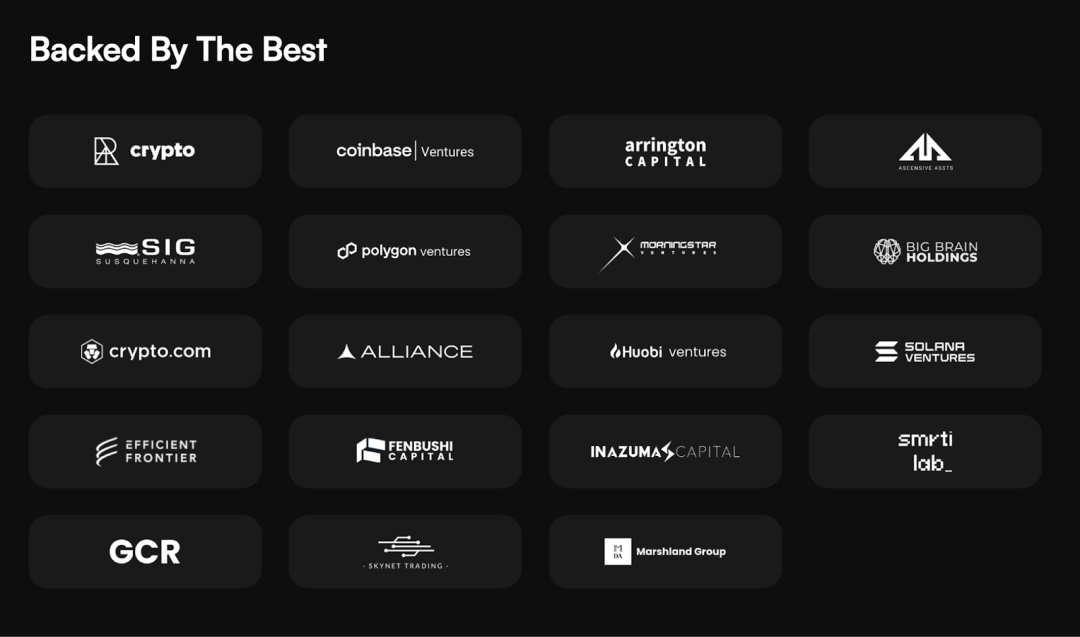
(zkLink investors Source: zkLink official website)
Future Outlook
The zkLink Nova mainnet is already live, and the team is upgrading the ZK Oracle lightweight node oracle network to verify cross-chain states as part of improving the zkLink X protocol.
In the future, zkLink will also undergo a series of important upgrades, including support for external data availability (DA) solutions, a decentralized proof auction market, and more.
Currently, zkLink's sequencing service is centrally managed, but the team plans to integrate decentralized solutions such as Espresso, Astria, and Fairblock to reduce centralization risks. In addition, the ZKL token is also set to be launched, and the team is preparing for the TGE.
It is evident that zkLink is continuously improving on the path to bringing unprecedented liquidity aggregation to Ethereum and its L2.
If achieving "seamless on-chain interaction" was once a dream, perhaps zkLink is turning that dream into reality.
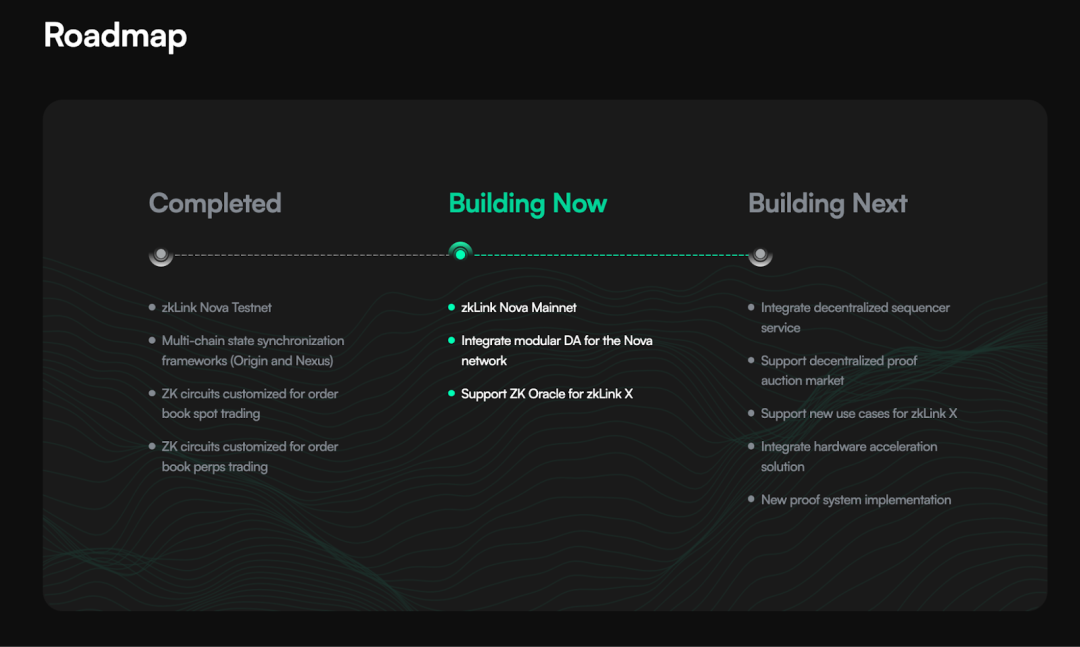
(zkLink roadmap Source: zkLink official website)
04 Conclusion
The battle between L1, L2, and L3 will ultimately reveal which layer will emerge as the ultimate winner, and only time will tell. At the same time, the market will also tell us that L1 and L2 will always have their necessary existence; this is not a zero-sum game.
The future is destined to be an era of multi-chain coexistence, and zkLink will also become a key hub, connecting various components and systems of the L1 and L2 ecosystems.
It can be imagined that zkLink is leading a more interconnected and multi-chain new era, bringing more new opportunities.
免责声明:本文章仅代表作者个人观点,不代表本平台的立场和观点。本文章仅供信息分享,不构成对任何人的任何投资建议。用户与作者之间的任何争议,与本平台无关。如网页中刊载的文章或图片涉及侵权,请提供相关的权利证明和身份证明发送邮件到support@aicoin.com,本平台相关工作人员将会进行核查。




